Ryobi TS1301 User Manual
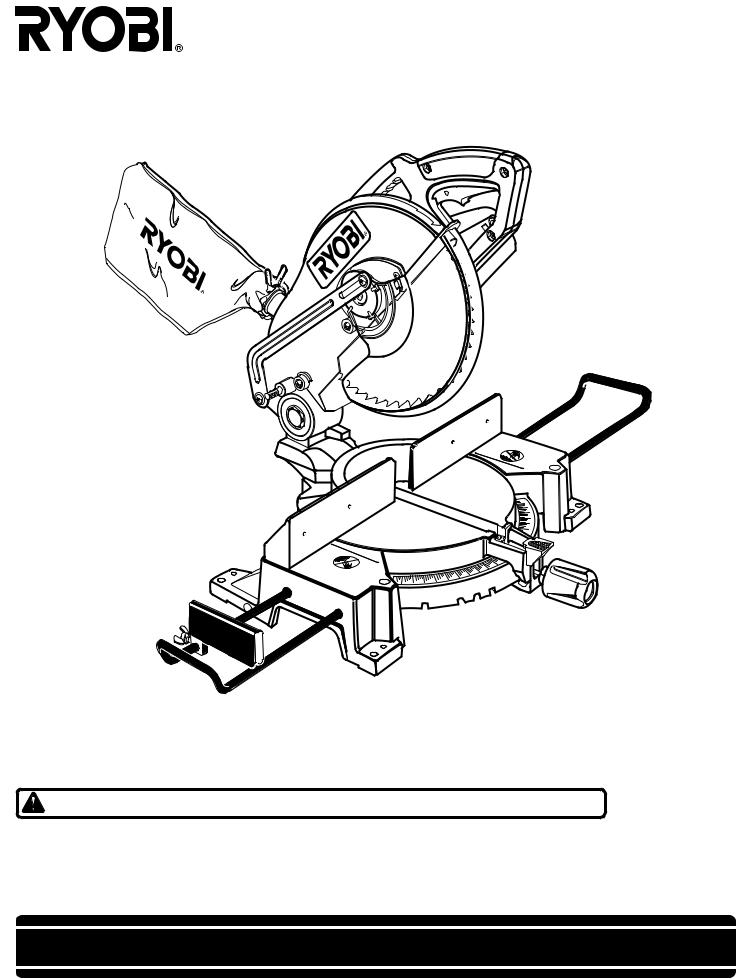
4 3
2
1
THANK YOU FOR BUYING A RYOBI MITER SAW.
Your new saw has been engineered and manufactured to Ryobi's high standards for dependability, ease of operation, and operator safety. Properly cared for, it will give you years of rugged, trouble-free performance.
CAUTION: Carefully read through this entire operator's manual before using your new saw.
Pay close attention to the Rules for Safe Operation, Warnings, and Cautions. If you use your saw properly and only for what it is intended, you will enjoy years of safe, reliable service.
Please fill out and return the Warranty Registration Card so we can be of future service to you.
Thank you again for buying Ryobi tools.
SAVE THIS MANUAL FOR FUTURE REFERENCE
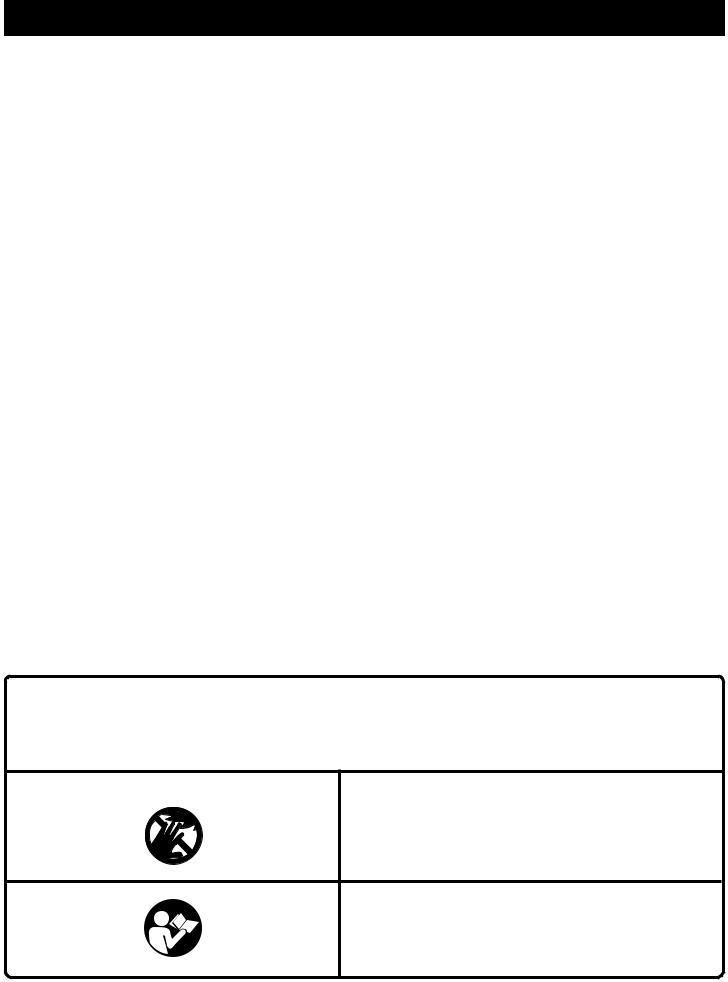
TABLE OF CONTENTS
Table Of Contents ........................................................... |
2 |
Safety and International Symbols ................................. |
2 |
Rules For Safe Operation ............................................ |
3-6 |
Additional Rules For Safe Operation For |
|
Miter Saws ................................................................... |
6 |
Product Specifications ................................................... |
7 |
Glossary Of Terms For Woodworking .......................... |
7 |
Unpacking And Checking Contents .............................. |
8 |
Loose Parts List ........................................................... |
8 |
Features ...................................................................... |
9-11 |
Know Your Miter Saw .............................................. |
9 |
14 Amp Motor .......................................................... |
9 |
10 in. (254 mm) Blade ............................................. |
9 |
Cutting Capacities ................................................... |
9 |
Blade Wrench / Storage Area .................................. |
9 |
Carrying Handle ...................................................... |
9 |
Miter Lock Handle ................................................. |
10 |
Spindle Lock Button .............................................. |
10 |
Trigger Lock .......................................................... |
10 |
Positive Stops On Miter Table ............................... |
10 |
Electric Brake ........................................................ |
10 |
Fence .................................................................... |
10 |
Self-Retracting Lower Blade Guard ....................... |
10 |
Mounting Holes ..................................................... |
11 |
Optional Accessories ............................................. |
11 |
Electrical Connection ............................................. |
11 |
Assembly .................................................................. |
12-15 |
Miter Lock Handle ................................................. |
12 |
Dust Guide ............................................................ |
12 |
To Install Blade ................................................. |
12-13 |
Dust Bag ................................................................ |
13 |
Table Extensions ................................................... |
14 |
Stop Block ............................................................. |
14 |
Work Clamp (Optional) .......................................... |
15 |
Adjustments ............................................................. |
15-17 |
Pivot Adjustments .................................................. |
15 |
Travel Pivot Adjustment ........................................ |
15 |
Squaring The Miter Table To The Fence .............. |
16 |
Squaring The Saw Blade To The Fence ............... |
17 |
Operation .................................................................. |
18-20 |
Applications ........................................................... |
18 |
Cutting With Your Miter saw .................................. |
18 |
Crosscutting .......................................................... |
18 |
To Crosscut With Your Miter saw .......................... |
18 |
Support Long Workpieces ..................................... |
19 |
Cutting Warped Material ........................................ |
20 |
Clamping Wide Workpieces .................................. |
20 |
Maintenance ............................................................. |
21-22 |
General .................................................................. |
21 |
Lubrication ............................................................. |
21 |
Extension Cords .................................................... |
21 |
Brush Replacement ............................................... |
22 |
Troubleshooting ............................................................ |
23 |
Extension Cord Caution ............................................... |
24 |
Parts Ordering / Service ............................................... |
24 |
SAFETY AND INTERNATIONAL SYMBOLS
This operator's manual describes safety and international symbols and pictographs that may appear on this product. Read the operator's manual for complete safety, assembly, operating and maintenance and repair information.
SYMBOL |
MEANING |
• NO HANDS SYMBOL
Failure to keep your hands away from the blade will result in serious personal injury.
•READ OPERATOR'S MANUAL
Failure to follow operating instructions and safety precautions in operator's manual can result in serious injury. Read operator's manual before starting or operating this unit.
Page 2
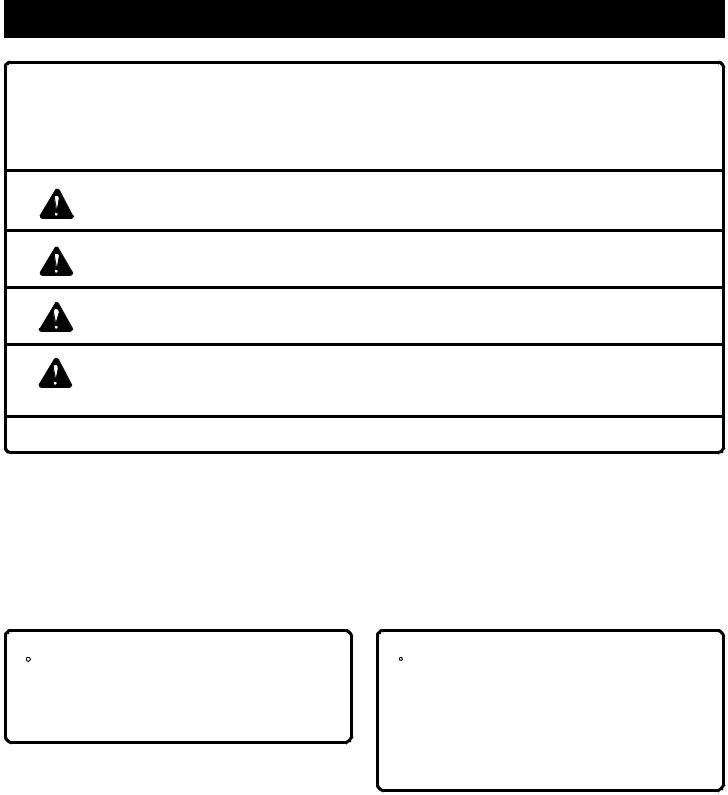
RULES FOR SAFE OPERATION
The purpose of safety symbols is to attract your attention to possible dangers. The safety symbols, and the explanations with them, deserve your careful attention and understanding. The safety warnings do not by themselves eliminate any danger. The instructions or warnings they give are not substitutes for proper accident prevention measures.
SYMBOL MEANING
SAFETY ALERT SYMBOL:
Indicates danger, warning, or caution. May be used in conjunction with other symbols or pictographs.
DANGER: Failure to obey a safety warning will result in serious injury to yourself or to others. Always follow the safety precautions to reduce the risk of fire, electric shock and personal injury.
WARNING: Failure to obey a safety warning can result in serious injury to yourself or to others. Always follow the safety precautions to reduce the risk of fire, electric shock and personal injury.
CAUTION: Failure to obey a safety warning may result in property damage or personal injury to yourself or to others. Always follow the safety precautions to reduce the risk of fire, electric shock and personal injury.
NOTE: Advises you of information or instructions vital to the operation or maintenance of the equipment.
DOUBLE INSULATION
Double insulation is a concept in safety, in electric power tools, which eliminates the need for the usual three-wire grounded power cord. All exposed metal parts are isolated from internal metal motor components with protecting insulation. Double insulated tools do not need to be grounded.
IMPORTANT
Servicing requires extreme care and knowledge and should be performed only by a qualified service technician. When servicing, use only identical Ryobi replacement parts. For service we suggest you return the tool to your nearest
RYOBI AUTHORIZED SERVICE CENTER for repair. Call 1- 800-525-2579 in the United State or visit our web site at www.ryobitools.com for your nearest RYOBI AUTHORIZED SERVICE CENTER.
 WARNING:
WARNING:
The double insulated system is intended to protect the user from shock resulting from a break in the tool's internal wiring. Observe all normal safety precautions related to avoiding electrical shock.
 WARNING:
WARNING:
Do not attempt to operate this tool until you have read thoroughly and understand completely all instructions, safety rules, etc. contained in this manual. Failure to comply can result in accidents involving fire, electric shock, or serious personal injury. Save this operator's manual and review frequently for continuing safe operation and instructing others who may use this tool.
Page 3

RULES FOR SAFE OPERATION
Safe operation of this power tool requires that you read and understand this operator's manual and all labels affixed to the tool. Safety is a combination of common sense, staying alert, and knowing how your miter saw works.
READ ALL INSTRUCTIONS
1.KNOW YOUR POWER TOOL. Read the operator's manual carefully. Learn the saw's applications and limitations as well as the specific potential hazards related to this tool.
2.GUARD AGAINST ELECTRICAL SHOCK BY PREVENTING BODY CONTACT WITH GROUNDED SURFACES. For example: pipes, radiators, ranges, refrigerator enclosures.
3.KEEP GUARDS IN PLACE and in good working order.
4.KEEP THE WORK AREA CLEAN. Cluttered work areas and work benches invite accidents. DO NOT leave tools or pieces of wood on the saw while it is in operation.
5.DO NOT USE IN DANGEROUS ENVIRONMENTS. Do not use power tools near gasoline or other flammable liquids, in damp or wet locations, or expose them to rain. Keep the work area well lit.
6.KEEP CHILDREN AND VISITORS AWAY. All visitors should wear safety glasses and be kept a safe distance from work area. Do not let visitors contact tool or extension cord while operating.
7.MAKE WORKSHOP CHILDPROOF with padlocks and master switches, or by removing starter keys.
8.DO NOT FORCE THE TOOL. It will do the job better and safer at the rate for which it was designed.
9.USE THE RIGHT TOOL. Do not force the tool or attachment to do a job it was not designed for. Don't use it for a purpose not intended.
10.DRESS PROPERLY. Do not wear loose clothing, gloves, neckties, rings, bracelets, or other jewelry. They can get caught and draw you into moving parts. Nonslip footwear is recommended when working outdoors. Also wear protective hair covering to contain long hair.
11.ALWAYS WEAR SAFETY GLASSES WITH SIDE SHIELDS. Everyday eyeglasses have only impactresistant lenses; they are NOT safety glasses.
12.PROTECT YOUR LUNGS. Wear a face or dust mask if the cutting operation is dusty.
13.PROTECT YOUR HEARING. Wear hearing protection during extended periods of operation.
14.DO NOT ABUSE CORD. Never yank cord to disconnect it from receptacle. Keep cord from heat, oil, and sharp edges.
15.DO NOT OVERREACH. Keep proper footing and balance at all times.
16.MAINTAIN TOOLS WITH CARE. Keep tools sharp and clean for better and safer performance. Follow instructions for lubricating and changing accessories.
17.DISCONNECT ALL TOOLS. When not in use, before servicing, or when changing attachments, blades, bits, cutters, etc., all tools should be disconnected.
18.REMOVE ADJUSTING KEYS AND WRENCHES. Get in the habit of checking to see that hex keys and adjusting wrenches are removed from tool before turning it on.
19.AVOID ACCIDENTAL STARTING. Be sure switch is off when plugging in.
20.USE THE PROPER EXTENSION CORD. Make sure your extension cord is in good condition. When using an extension cord, be sure to use one heavy enough to carry the current your product will draw. An undersized cord will cause a drop in line voltage resulting in loss of power and overheating. A wire gage size (A.W.G.) of at least 14 is recommended for an extension cord 25 feet or less in length. If in doubt, use the next heavier gage. The smaller the gage number, the heavier the cord.
21.USE OUTDOOR EXTENSION CORDS. When tool is used outdoors, use only extension cords with approved ground connection that are intended for use outdoors and so marked.
22.KEEP BLADES CLEAN AND SHARP. Sharp blades minimize stalling and kickback.
23.KEEP HANDS AWAY FROM CUTTING AREA. Keep hands away from blades. Do not reach underneath work or around or under the blade while blade is rotating. Do not attempt to remove cut material when blade is moving.
 WARNING: Blades coast after turn off.
WARNING: Blades coast after turn off.
24.NEVER USE IN AN EXPLOSIVE ATMOSPHERE.
Normal sparking of the motor could ignite fumes.
25.INSPECT TOOL CORDS PERIODICALLY and if damaged, have repaired at your nearest AUTHORIZED SERVICE CENTER. Stay constantly aware of cord location and keep it well away from the rotating blade.
26.INSPECT EXTENSION CORDS PERIODICALLY and replace if damaged.
27.KEEP TOOL DRY, CLEAN, AND FREE FROM OIL AND GREASE. Always use a clean cloth when cleaning. Never use brake fluids, gasoline, petroleum-based products, or any solvents to clean tool.
28.STAY ALERT AND EXERCISE CONTROL. Watch what you are doing and use common sense. Do not operate tool when you are tired. Do not rush.
Page 4
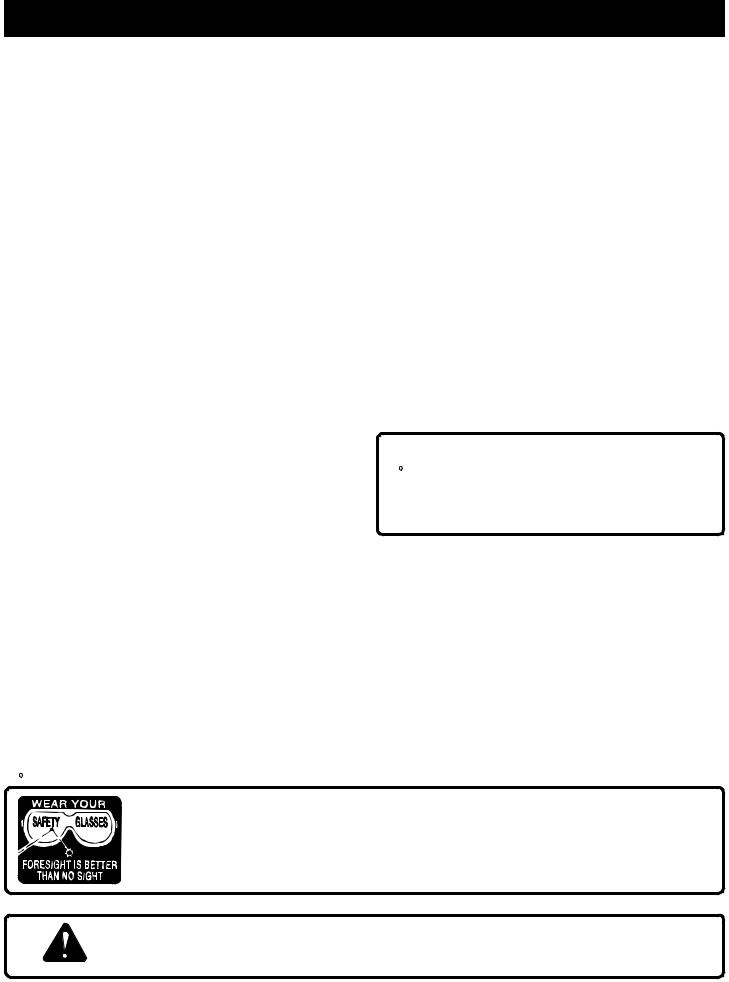
RULES FOR SAFE OPERATION
29.CHECK DAMAGED PARTS. Before further use of the tool, a guard or other part that is damaged should be carefully checked to determine that it will operate properly and perform its intended function. Check for alignment of moving parts, binding of moving parts, breakage of parts, mounting and any other conditions that may affect its operation. A guard or other part that is damaged must be properly repaired or replaced by an authorized service center to avoid risk of personal injury.
30.DO NOT USE TOOL IF SWITCH DOES NOT TURN IT ON AND OFF. Have defective switches replaced by an authorized service center.
31.USE THE FENCE. Always use the fence when cutting.
32.SUPPORT LONG WORKPIECES. To minimize risk of blade pinching and kickback, always support long workpieces.
33.BEFORE MAKING A CUT, BE SURE ALL ADJUSTMENTS ARE SECURE.
34.USE ONLY CORRECT BLADES. Do not use blades with incorrect size holes. Never use blade washers or blade screws that are defective or incorrect. The maximum blade capacity of your saw is 10 in. (254 mm).
35.USE RECOMMENDED ACCESSORIES. The use of improper accessories may cause risk of injury. Consult operator's manual for recommended accessories.
36.NEVER STAND ON TOOL. Serious injury could occur if the tool is tipped or if the blade is unintentionally contacted.
37.POLARIZED PLUGS. To reduce the risk of electric shock, this tool has a polarized plug (one blade is wider than the other). This plug will fit in a polarized outlet only one way. If the plug does not fit fully in the outlet, reverse the plug. If it still does not fit, contact a qualified electrician to install the proper outlet. Do not change the plug in any way.
38.NEVER LEAVE TOOL RUNNING UNATTENDED. TURN THE POWER OFF. Do not leave tool until it comes to a complete stop.
39.TURN TOOL OFF AND WAIT FOR SAW BLADE TO STOP BEFORE RAISING SAW HEAD, MOVING WORK, OR CHANGING SETTINGS.
40.AVOID CUTTING NAILS. Inspect for and remove all nails from lumber before cutting.
41.NEVER TOUCH BLADE or other moving parts during use.
42.NEVER START A TOOL WHEN THE BLADE IS IN CONTACT WITH THE WORKPIECE.
43.DO NOT OPERATE THIS TOOL WHILE UNDER THE INFLUENCE OF DRUGS, ALCOHOL, OR ANY MEDICATION.
44.SECURE WORK. Use clamps or a vise to hold work when practical. It's safer than using your hand and it frees both hands to operate tool.
45.REPLACEMENT PARTS. All repairs, whether electrical or mechanical, should be made at your nearest Authorized Service Center.
 WARNING:
WARNING:
When servicing use only identical Ryobi replacement parts. Use of any other parts may create a hazard or cause product damage.
46.SAVE THESE INSTRUCTIONS. Refer to them frequently and use them to instruct other users. If you loan someone this tool, loan them these instructions also.
 WARNING:
WARNING:
The operation of any power tool can result in foreign objects being thrown into your eyes, which can result in severe eye damage. Before beginning tool operation, always wear safety goggles or safety glasses with side shields and a full face shield when needed. We recommend Wide Vision Safety Mask for use over eyeglasses or standard safety glasses with side shields. Always wear eye protection which is marked to comply with ANSI Z87.1.
Look for this symbol to point out important safety precautions. It means attention!!! Your safety is involved.
Page 5
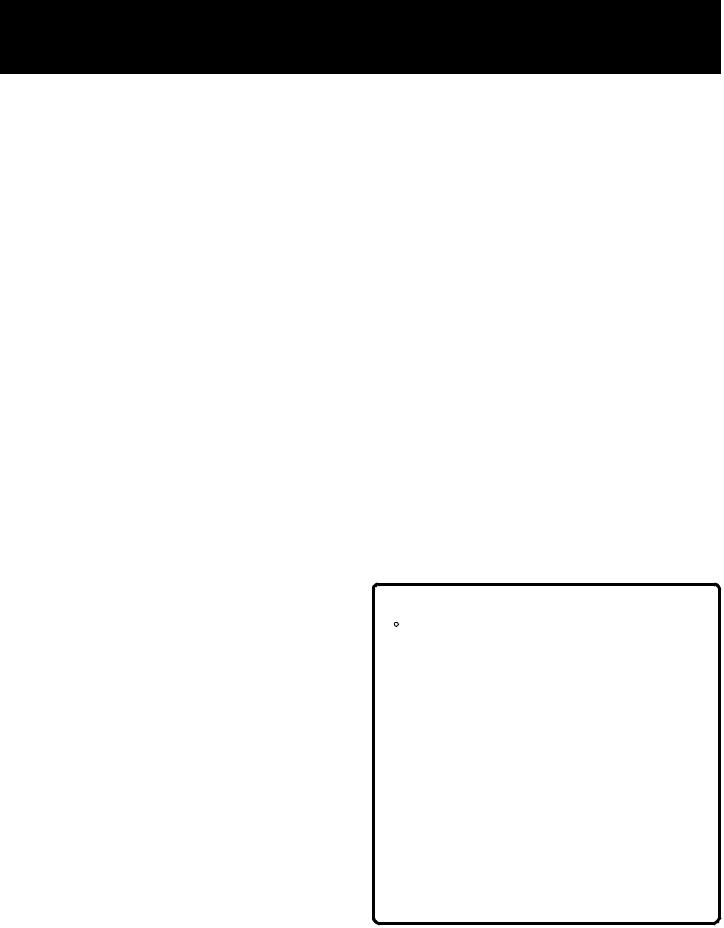
Additional Rules For Safe Operation
For Miter Saws
1.NEVER USE A DULL SAW BLADE or one that does not have sufficient set.
2.DO NOT REMOVE THE SAW'S BLADE GUARDS.
Never operate the saw with any guard or cover removed. Make sure all guards are operating properly before each use.
3.MAKE SURE THE MITER TABLE IS LOCKED IN POSITION BEFORE OPERATING YOUR SAW. Lock the miter table by securely tightening the miter lock handle.
4.NEVER PERFORM ANY OPERATION "FREEHAND".
Always place the workpiece to be cut on the miter table and position it firmly against the fence as a backstop.
5.ALWAYS USE A CLAMP to secure the workpiece when possible.
6.NEVER hand hold a workpiece that is too small to be clamped. Keep hands clear of the no hands zone.
7.NEVER reach behind or under the blade and its cutting path with your hands and fingers for any reason.
8.NEVER stand or have any part of your body in line with the path of the saw blade.
9.ALLOW THE MOTOR TO COME UP TO FULL SPEED before starting a cut.
10.ALWAYS release the power switch and allow the saw blade to stop rotating before raising it out of the workpiece.
11.NEVER reach to pick up a workpiece, a piece of scrap, or anything else that is in or near the cutting path of the blade.
12.NEVER leave the miter saw unattended while connected to a power source.
13.FIRMLY CLAMP OR BOLT your miter saw to a workbench or table. The most comfortable saw table height is 39 inches or at approximately hip height.
14.AVOID AWKWARD OPERATIONS AND HAND POSITIONS where a sudden slip could cause your hand to move into the blade. ALWAYS make sure you have good balance. NEVER operate your miter saw on the floor or in a crouched position.
15.ALWAYS PROVIDE ADEQUATE ROOM AND SUPPORT for crosscutting long workpieces.
16.NEVER USE A LENGTH STOP ON THE FREE SCRAP END OF A CLAMPED WORKPIECE. NEVER hold onto or bind the free scrap end of the workpiece in any operation. If a work clamp and length stop are used together, they must both be installed on the same side of the saw table to prevent the saw from catching the loose end and kicking up.
17.DO NOT TURN THE MOTOR SWITCH ON AND OFF RAPIDLY. This could cause the saw blade to loosen and could create a hazard. Should this ever occur, stand clear and allow the saw blade to come to a complete stop. Disconnect your saw from the power supply and securely retighten the blade bolt.
18.NEVER cut more than one piece at a time. DO NOT STACK more than one workpiece on the saw table at a time.
19.IF ANY PART OF THIS MITER SAW IS MISSING or should break, bend, or fail in any way, or should any electrical component fail to perform properly, shut off the power switch, remove the miter saw plug from the power source and have damaged, missing, or failed parts replaced before resuming operation.
20.ALWAYS STAY ALERT! Do not allow familiarity (gained from frequent use of your saw) to cause a careless mistake. ALWAYS REMEMBER that a careless fraction of a second is sufficient to inflict severe injury.
21.MAKE SURE THE WORK AREA HAS AMPLE LIGHTING to see the work and that no obstructions will interfere with safe operation BEFORE performing any work using your saw.
22.ALWAYS TURN OFF SAW before disconnecting it, to avoid accidental starting when reconnecting to power supply.
23.SAVE THESE INSTRUCTIONS. Refer to them frequently and use to instruct other users. If you loan someone this tool, loan them these instructions also.
 WARNING:
WARNING:
Some dust created by power sanding, sawing, grinding, drilling, and other construction activities contains chemicals known to cause cancer, birth defects or other reproductive harm. Some examples of these chemicals are:
•lead from lead-based paints,
•crystalline silica from bricks and cement and other masonry products, and
•arsenic and chromium from chemically-treated lumber.
Your risk from these exposures varies, depending on how often you do this type of work. To reduce your exposure to these chemicals: work in a well ventilated area, and work with approved safety equipment, such as those dust masks that are specially designed to filter out microscopic particles.
SAVE THESE INSTRUCTIONS
Page 6

|
|
PRODU T |
|
|
|
||
|
|
|
ESPECISPECIFICATIONSES |
|
|
|
|
Blade Diameter .................................................................................................................................. |
|
|
10 in. (254 mm) |
Blade Arbor ........................................................................................................................................ |
|
|
5/8 in. (16 mm) |
No Load Speed ........................................................................................................................................ |
|
|
5,000 RPM |
Rating ................................................................................................................................ |
|
|
120 Volts, 60 Hz-AC Only |
Input ........................................................................................................................................................ |
|
|
14 Amperes |
Cutting Capacities: |
|
|
|
At 90° : |
H |
x |
W |
Max Width: |
2-5/8" |
x |
5-3/4" |
Max Height: |
3-1/4" |
x |
3-1/2" |
At 45° : |
H |
x |
W |
Max Width: |
2-3/4" |
x |
4" |
Max Height: |
3-1/4" |
x |
3-1/4" |
Tool Weight .................................................................................................................................. |
|
|
28.2 lbs. (12.8 kg.) |
GLOSSARY OF TERMS FOR WOODWORKING
Arbor
The shaft on which a blade or cutting tool is mounted.
Crosscut
A cutting or shaping operation made across the grain of the workpiece.
Freehand
Performing a cut without using a fence, miter gage, fixture, work clamp, or other proper device to keep the workpiece from twisting during the cut.
Gum
A sticky, sap based residue from wood products.
Miter Cut
A cutting operation made with the wood at any angle other than 90 degrees to the fence.
Resin
A sticky, sap base substance that has hardened.
Revolutions Per Minute (RPM)
The number of turns completed by a spinning object in one minute.
Saw Blade Path
The area over, under, behind, or in front of the blade. As it applies to the workpiece, that area which will be, or has been, cut by the blade.
Set
The distance that the tip of the saw blade tooth is bent (or set) outward from the face of the blade.
Throw-Back
Throwing of a workpiece in a manner similar to a kickback. Usually associated with a cause other than the kerf closing, such as a workpiece not being against the fence, being dropped into the blade, or being placed inadvertently in contact with the blade.
Through Sawing
Any cutting operation where the blade extends completely through the thickness of the workpiece.
Workpiece
The item on which the cutting operation is being done. The surfaces of a workpiece are commonly referred to as faces, ends, and edges.
No Hands Zone
The area between the marked lines on the left and right side of the miter table base. This zone is identified by no hands zone labels placed inside the marked lines on the miter table base. The operator's hands must stay clear of this area during any operation of the saw.
Page 7
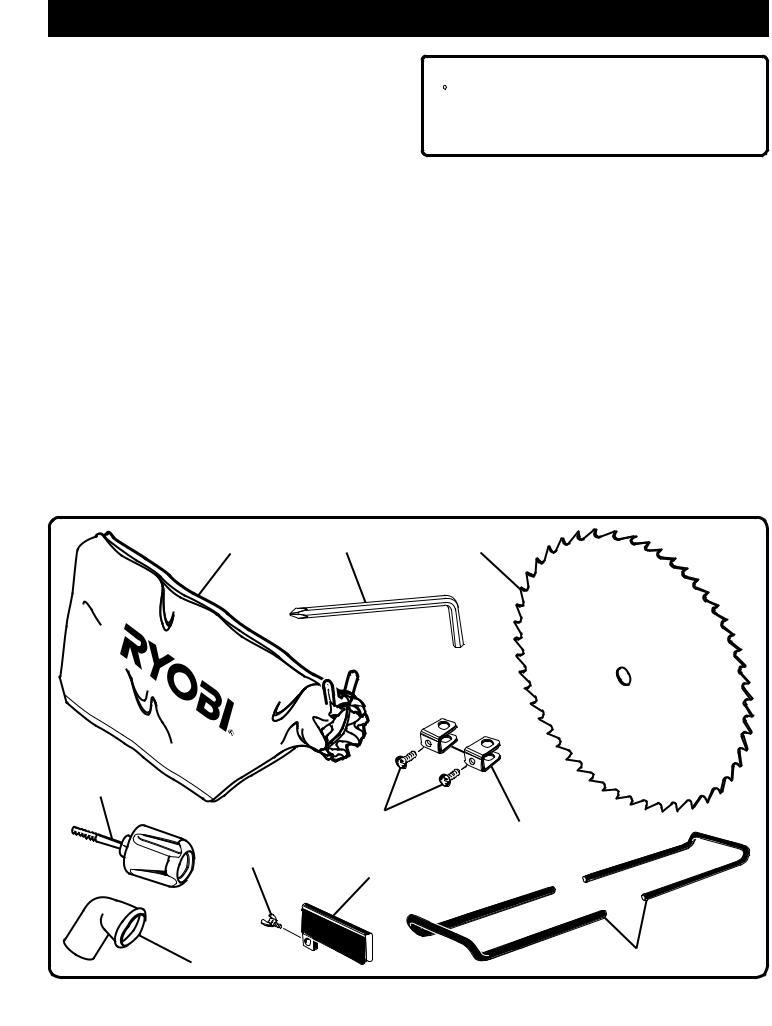
UNPACKING AND CHECKING CONTENTS
Your Miter Saw has been shipped completely assembled except for the blade, miter lock handle, dust guide or dust bag, table extensions, and stop block.
■Remove all loose parts from the carton. Separate and check with the list of Loose Parts. See Figure 1.
■Remove the packing materials from around your saw.
 WARNING:
WARNING:
If any parts are missing do not operate your saw until the missing parts are replaced. Failure to do so could result in possible serious injury.
■Carefully lift saw from the carton and place it on a level work surface. Although small, this saw is heavy. To avoid back injury, get help when needed.
■Do not discard the packing materials until you have carefully inspected the saw, identified all loose parts, and satisfactorily operated your new saw.
■Your saw has been shipped with the saw arm locked in the down position. To release saw arm, push down on top of saw arm and pull out the lock pin. See Figure 3.
■Lift the saw arm by the handle. Hand pressure should remain on the saw arm to prevent sudden rise upon release of the lock pin.
■Examine all parts to make sure no breakage or damage has occurred during shipping.
If any parts are damaged or missing, do not attempt to plug in the power cord and turn the switch on until the damaged or missing parts are obtained and are installed correctly. Contact your nearest Ryobi dealer or call 1-800-525-2579 in the United States for assistance if any parts are missing or damaged.
LOOSE PARTS LIST
The following items are included with your Miter Saw:
■10 in. (254 mm) Blade
■Miter Lock Handle
■Dust Bag
■Dust Guide
■Stop Block
■Small Wing Screw (for use with stop block)
■Table Extensions (2)
■Clamp Bracket (2), (for use with table extensions)
■Clamp Bracket Screw (2), (for use with table extensions)
■Blade Wrench (1/4 in. Hey Key/Phillips Screwdriver)
■Operator's Manual
■Warranty Registration
Some models may include one or more of the following accessories:
■Work Clamp
■8 mm Work Clamp Screw
DUST BAG |
BLADE WRENCH |
SAW BLADE |
MITER
LOCK HANDLE
CLAMP
BRACKET SCREWS
CLAMP BRACKETS
SMALL
WING SCREW
STOP BLOCK
DUST GUIDE |
TABLE EXTENSIONS |
Fig. 1 |
|
Page 8 |
|
